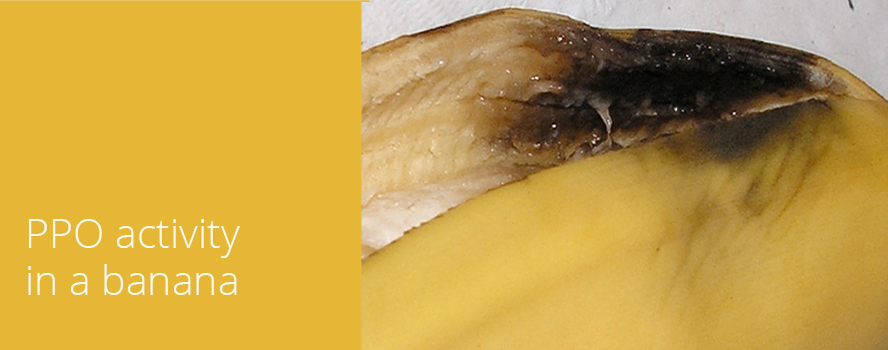Polyphenol Oxidase Enzymes Cause Browning of Fruit and Vegetables
by Helga George, Ph.D.
Polyphenol oxidases oxidize polyphenols found in fruits and vegetables, causing postharvest disorders such as avocado browning to occur.
Polyphenol oxidase (PPO) enzymes, also known as polyphenoloxidases, are able to catalyze the transformation of an array of aromatic compounds that have two adjacent phenolic groups on them. This includes a number of polyphenols in plants that act as antioxidants. These copper-containing enzymes oxidize the phenolic groups to reactive oxygen molecules known as quinones, which continue reacting with each other and other cellular factors to form brown spots known as melanin. This browning causes the deterioration of fruits and vegetables, causing large economic losses. Examples include the browning of bananas and avocados.
What are Polyphenol Oxidases?
Polyphenol oxidases are a widespread group of enzymes found in plants, fungi, bacteria, and animals. In plants, these enzymes are usually found in the chloroplasts, although they can be released from this compartment during ripening or senescence. The enzymes contain copper at their active site. This metal ion enables them to oxidize the phenolic group of an aromatic compound to a reaction group known as a quinone. Quinones are reactive oxygen molecules bound to a carbon atom by two double bonds.
There are two types of PPOs. Catechol oxidase can catalyze an aromatic group with two adjacent phenols, a diphenol, to become two quinones. This is a relatively easy reaction to carry out. More difficult is tyrosinase (monophenolase) activity, which involves introducing one atom of oxygen onto an aromatic group with one phenolic group on it, changing it to a diphenol. Then, the enzyme will mediate catechol oxidase activity on the molecule, transforming it to a molecule with two quinones. Tyrosinase enzymes are also responsible for producing the melanin pigments in our skin.
Polyphenol Oxidases Cause Enzymatic Browning in Foods
Fruits and vegetables are full of polyphenolic compounds that can act as substrates for PPOs. Chlorogenic acid, caffeic acid, epicatechin, and catechin are all polyphenols commonly found in fruits and vegetables that can be oxidized to quinones by PPOs. Such quinones are very reactive and can react with each other and surrounding proteins to generate a black pigment called melanin. This causes dark spots to form in the plant tissue, frequently making the fruit or vegetable inedible. Substantial losses can be caused by PPO activity. Fruit become particularly susceptible as they ripen.
The reaction frequently does not happen until oxygen is introduced. For instance, when an apple is cut open, the surface will be white. After a short period of time, however, it turns brown. The browning of apples is a visible manifestation of the oxidation of the phenolics in the apple. Sometimes, PPO activity is desired, such as when tea, coffee, or chocolate is processed.
Polyphenol Oxidation is Widespread
Aromatic phenolic compounds are present in large amounts in many fruits and vegetables. These polyphenols act as substrates for polyphenol oxidase enzymes, which are produced by a number of different organisms. The activity of plant PPOs can cause browning and blackening of a number of fruits and vegetables. PPOs contain copper and react with oxygen and the phenolic compounds in plants to generate reactive quinones. These quinones frequently continuing reacting with each other and nearby proteins to generate brown pigments. Such pigments result in the enzymatic browning of fruits and vegetables and often render food unfit for consumption.
References:
Coleman, B. 5-13-2009. “Tea Pressing.” Suite101.com
Mayer, A.M. 2006. “Polyphenol oxidases in plants and fungi: going places? A review.” Phytochemistry. 67:2318-2331.
Wageningen University. 3-31-2010. “Enzymatic Browning.” Food-info.net
QUICK LINKS TO ALL
Suite.io Articles
by Helga George, Ph.D.
AGRICULTURAL SCIENCE
• Polyphenol Oxidase Enzymes Cause Browning of Fruits and Vegetables
CHEMICAL ECOLOGY
• Domoic Acid Poisoning in Sea Lions
• Insects that Make Cyanide
PLANT PATHOLOGY
• Plants Produce Chemicals as a Defense Against Pathogens
• Wheat Rust Threatens World’s Wheat Crops
• Biotrophic Versus Necrotrophic Fungi
• Fungal Haustoria Absorb Nutrients from Living Plant Cells
• The Gene-for-Gene Concept: a Central Tenet in Plant Pathology
GARDENING
• Oenothera speciosa—a Drought Tolerant Perennial Groundcover
• The Magic Lily—a Drought Tolerant Species of Lycoris
SOIL MICROBIOLOGY
• Streptomyces, Antibiotics, and Microbial Conflict in the Soil
AGRICULTURE IN SANTA BARBARA COUNTY
• Chrysanthemum White Rust Outbreak in Southern California

